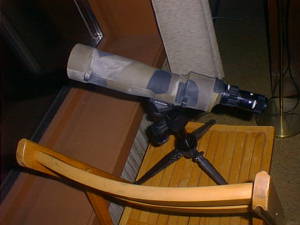Tuesday 3 February 2004

|
Pic of the day: Still from a distance. Wishing for the moonI was looking at the moon, which will soon be full again. I was thinking of the plans announced first by George W. Bush to take America back to the moon and then to Mars, and the more recent (and more detailed) plans by the European Union for the same thing. First return to the moon, then onward to Mars. Actually the Chinese may have announced moon plans before the both of them, but they were quite vague about whether their moon base would be manned or robotic. ***Thinking back to the sixties, it now seems little less than a miracle that humans made it safely to the moon and back. Not just once, but repeatedly ... although one of the runs very nearly ended in disaster. In the years since then, great progress has been made in materials technology, particularly ceramics but also metallics. Computer systems are far cheaper, smaller, faster, and use less power. Yes, there tend to be more bugs, but this is because systems are now often very complex. If we make modular, limited programs it is perfectly possible to keep them reliable. Computer systems that assist the human crew would make the trip easier and safer, and new materials and improved propulsion systems would be cheaper and more efficient. We could go back to the moon easily, if we had a good reason. It is kind of sad if the only reason to return was another space race, this time with China and the USA and the EU. There are scientists who think that there are good reasons to go back to gain more information, after we have processed the stones and the measurements taken during the Apollo program. We now have entirely different theories about the origin of the moon, thanks not least to those samples brought back to Earth. Before Apollo, it was common to think that the moon was a smaller planet caught by Earth's gravity. Today it is generally accepted that the smaller planet crashed into the young Earth with tremendous force, basically smashing it to pieces again. The lighter pieces settled into a ring that eventually coalesced into the moon. The heavier parts stayed together (or soon fell back together) as the current Earth. This would explain that the moon is not only lighter, but chemically different from the other stone planets. Who knows what else we might learn if we took the time to study it in detail, at the site? ***But the best reason, in my opinion, is for the sake of the children. I remember the excitement back then, and I look at young people now debating whether humans have even been to the moon. It seems so far away, I guess. I think we need it. Need the sight of humans walking on a celestial body. And above all, we need the pictures of Earth, a small bluish orb rising over the ragged and lifeless stone desert, reminding us of how small this place is, and how precious, like a beautiful cradle for the infant mankind. We should go to the moon because we need witnesses.
One day, says Galileo, a man will reach the sky Chris de Burgh: Discovery. Note to my subconscious: Thought you were funny now, huh? Making me cite the exact same lyrics as 3 years ago without having read that entry in a long time. Or is it just a coincidence? |
Mild. |
Yesterday <-- This month --> Tomorrow?